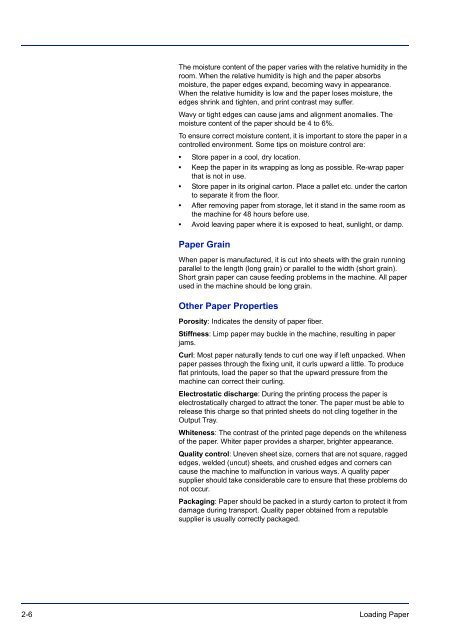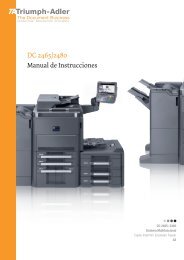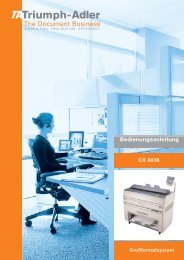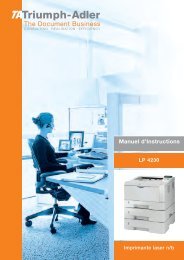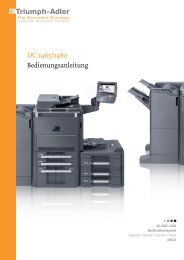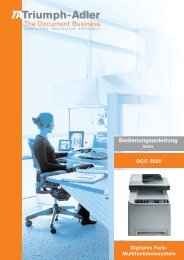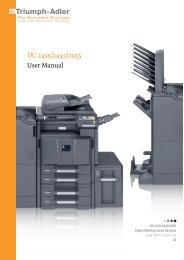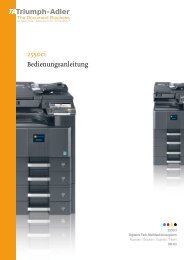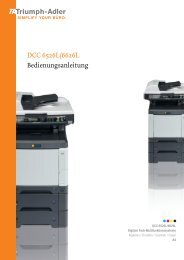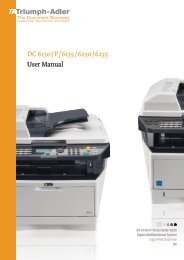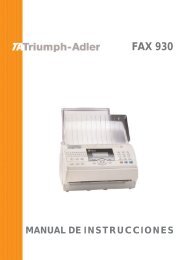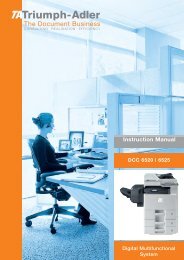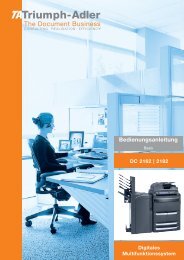Instruction Handbook - TA Triumph-Adler
Instruction Handbook - TA Triumph-Adler
Instruction Handbook - TA Triumph-Adler
Create successful ePaper yourself
Turn your PDF publications into a flip-book with our unique Google optimized e-Paper software.
The moisture content of the paper varies with the relative humidity in the<br />
room. When the relative humidity is high and the paper absorbs<br />
moisture, the paper edges expand, becoming wavy in appearance.<br />
When the relative humidity is low and the paper loses moisture, the<br />
edges shrink and tighten, and print contrast may suffer.<br />
Wavy or tight edges can cause jams and alignment anomalies. The<br />
moisture content of the paper should be 4 to 6%.<br />
To ensure correct moisture content, it is important to store the paper in a<br />
controlled environment. Some tips on moisture control are:<br />
• Store paper in a cool, dry location.<br />
• Keep the paper in its wrapping as long as possible. Re-wrap paper<br />
that is not in use.<br />
• Store paper in its original carton. Place a pallet etc. under the carton<br />
to separate it from the floor.<br />
• After removing paper from storage, let it stand in the same room as<br />
the machine for 48 hours before use.<br />
• Avoid leaving paper where it is exposed to heat, sunlight, or damp.<br />
Paper Grain<br />
When paper is manufactured, it is cut into sheets with the grain running<br />
parallel to the length (long grain) or parallel to the width (short grain).<br />
Short grain paper can cause feeding problems in the machine. All paper<br />
used in the machine should be long grain.<br />
Other Paper Properties<br />
Porosity: Indicates the density of paper fiber.<br />
Stiffness: Limp paper may buckle in the machine, resulting in paper<br />
jams.<br />
Curl: Most paper naturally tends to curl one way if left unpacked. When<br />
paper passes through the fixing unit, it curls upward a little. To produce<br />
flat printouts, load the paper so that the upward pressure from the<br />
machine can correct their curling.<br />
Electrostatic discharge: During the printing process the paper is<br />
electrostatically charged to attract the toner. The paper must be able to<br />
release this charge so that printed sheets do not cling together in the<br />
Output Tray.<br />
Whiteness: The contrast of the printed page depends on the whiteness<br />
of the paper. Whiter paper provides a sharper, brighter appearance.<br />
Quality control: Uneven sheet size, corners that are not square, ragged<br />
edges, welded (uncut) sheets, and crushed edges and corners can<br />
cause the machine to malfunction in various ways. A quality paper<br />
supplier should take considerable care to ensure that these problems do<br />
not occur.<br />
Packaging: Paper should be packed in a sturdy carton to protect it from<br />
damage during transport. Quality paper obtained from a reputable<br />
supplier is usually correctly packaged.<br />
2-6 Loading Paper


